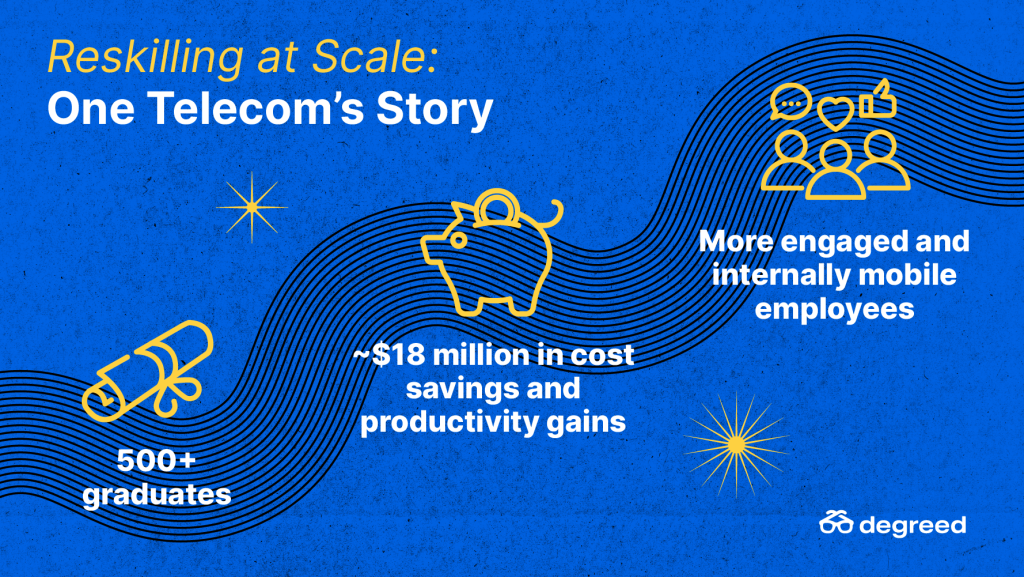In response to a pressing demand for high-tech skills, a Canadian telecom company faced a familiar dilemma: how to attract talent in a fiercely competitive market.
External hiring is expensive. It takes time, and turnover is high. Indeed, about half (53%) of hiring managers across Canada say finding people with the right skills is their biggest challenge. That’s why learning leaders at the telecommunications firm instead turned to the company’s workforce. The goal? Reskill existing employees with the high-tech skills of tomorrow.
An internal workforce development program created by the company successfully graduated more than 500 professionals with specialized qualifications in high-tech fields. What’s more, the program led to happier and more successful employees and an estimated $18 million in cost savings and productivity gains.

The Program: A Skills-First Approach to Learning
Like many others, this telecommunications operator experienced a rapid digital transformation. This shifted the demand for workers from traditional retail and technician roles to more advanced positions in software development, AI, cloud computing, and cybersecurity.
“We have very dedicated, engaged, and talented employees,” the company’s director of learning strategy said, adding that the organization was committed to adapting this enthusiastic and hardworking workforce for the future. “So the question was: With a surplus of people on one side, how do we create a bridge to the skills we need?”
Choosing Degreed
With an emphasis on quick and easy-to-access online learning, comprehensive curriculum development led by subject-matter experts from across the organization, and with a rigorous selection process focused on diversity, the strategy came alive. It’s a multi-pronged model—a customized online learning program followed by a two- to three-month temporary job placement for real-world practice.
With online learning as the foundation and skills as the key measurement of progress, the firm looked to Degreed to curate content and manage skills.
“We needed a place that made it easy to build curriculums and tie the pieces together. Not just the clicks to the content, but also the storytelling around it, and Degreed is really good at that compared to other platforms,” the learning strategy director said. “Degreed also allows us to build community by putting cohorts in virtual Groups where they can support each other.”
Managing Skills
“The only reason we were able to do all of this is because we were very laser-focused on skills and the proficiency levels needed for each skill in the reskilling process, “ the learning director said. “At the same time, we already had a little under 2,000 team members in technical fields who needed to stay upskilled. That was why we turned to Degreed—for both the reskilling of new talent and the upskilling of our existing technical workforce.”

The Results: More Engaged Employees, and Lower Costs
The results have been impressive, including:
- Improved retention and satisfaction. The program in four-and-a-half years boosted retention among participants by more than 10% above the company average, with an average annual participant retention rate of 98%. Participant engagement and satisfaction levels exceed company averages by 8% and 10% points, respectively.
- Career advancement. More thanA substantial 22% of graduates were have been promoted following completion of the program, highlighting its role in career progression.
- Financial impact. The program has already delivered an estimated $18 million in return on investment (ROI), through cost savings from new hire recruitment and productivity gains.
The program is also about creating opportunities for graduates. “The number one measure of success we use is being able to say, ‘Here’s your new job offer. Here’s your new salary. Here’s your new title,’” the learning director said.
Lessons Learned: Turning Executives into Deans
A key to the success of the program is its strong executive sponsorship—starting at the top with executives who play the role of “deans” in their areas of expertise, to directors representing each business unit, to subject matter experts who help develop the curriculum.
“Those three layers of sponsorship give people pride, the learning director said. “At the same time, everyone knows this is a CEO priority. Having that governance and that structure is super important for getting resources—and that included getting funding for Degreed.”
Learning leaders also attribute success to the combination of structured online Pathways in Degreed and on-the-job, experiential learning for participants to reinforce skills, expand their networks, and meet a potential hiring leader. The program includes biweekly touchpoints designed to help cohorts overcome roadblocks.
Seeing the results in action “feels amazing,” the learning director said. “I recently saw that a man who used to work in a retail branch just won an internal award for outstanding software development. He doesn’t have a university degree, but he participated in the program, built up his skills, and is absolutely stellar in his new career.”
Your company can reskill at scale too.
Your company can transform workers into award-winning software developers—or fill other critical roles.
It’s just a matter of following the telecom’s model of building scalable, personalized content and finding the right tools that support reskilling.
And if you do it right, you’ll not only prepare your company for the high-tech future, but you’ll boost employee morale and can save your company millions. Those kinds of reskilling returns beat the risky and expensive strategy of buying skills every time.
Find out more.
Join us at Degreed LENS 2025, where learning pioneers will share insights, best practices, and bold visions for the future of work.

